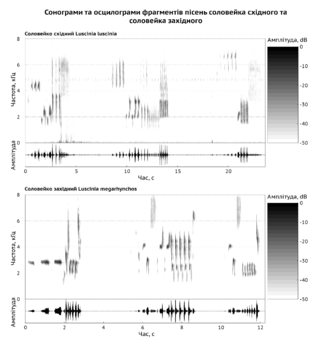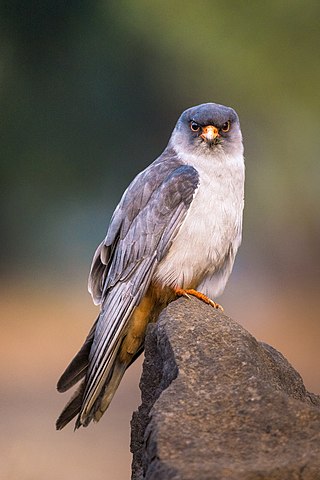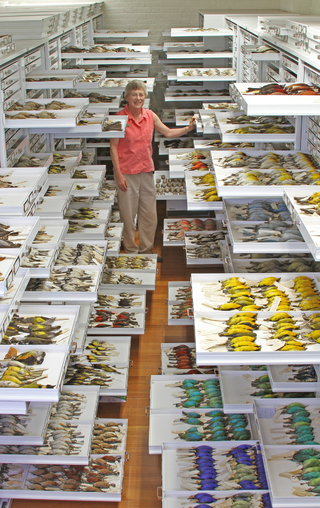Related Research Articles

Ornithology is a branch of zoology that concerns the study of birds. Several aspects of ornithology differ from related disciplines, due partly to the high visibility and the aesthetic appeal of birds. It has also been an area with a large contribution made by amateurs in terms of time, resources, and financial support. Studies on birds have helped develop key concepts in biology including evolution, behaviour and ecology such as the definition of species, the process of speciation, instinct, learning, ecological niches, guilds, island biogeography, phylogeography, and conservation.

Bird migration is the regular seasonal movement, often north and south, along a flyway, between breeding and wintering grounds. Many species of bird migrate. Migration carries high costs in predation and mortality, including from hunting by humans, and is driven primarily by the availability of food. It occurs mainly in the northern hemisphere, where birds are funnelled onto specific routes by natural barriers such as the Mediterranean Sea or the Caribbean Sea.

The swallows, martins, and saw-wings, or Hirundinidae are a family of passerine songbirds found around the world on all continents, including occasionally in Antarctica. Highly adapted to aerial feeding, they have a distinctive appearance. The term "swallow" is used colloquially in Europe as a synonym for the barn swallow. Around 90 species of Hirundinidae are known, divided into 19 genera, with the greatest diversity found in Africa, which is also thought to be where they evolved as hole-nesters. They also occur on a number of oceanic islands. A number of European and North American species are long-distance migrants; by contrast, the West and South African swallows are nonmigratory.

Herons are long-legged, long-necked, freshwater and coastal birds in the family Ardeidae, with 72 recognised species, some of which are referred to as egrets or bitterns rather than herons. Members of the genera Botaurus and Ixobrychus are referred to as bitterns, and, together with the zigzag heron, or zigzag bittern, in the monotypic genus Zebrilus, form a monophyletic group within the Ardeidae. Egrets do not form a biologically distinct group from herons, and tend to be named differently because they are mainly white or have decorative plumes in breeding plumage. Herons, by evolutionary adaptation, have long beaks.

The common starling, also known as the European starling in North America and simply as the starling in Great Britain and Ireland, is a medium-sized passerine bird in the starling family, Sturnidae. It is about 20 cm (8 in) long and has glossy black plumage with a metallic sheen, which is speckled with white at some times of year. The legs are pink and the bill is black in winter and yellow in summer; young birds have browner plumage than the adults. It is a noisy bird, especially in communal roosts and other gregarious situations, with an unmusical but varied song. Its gift for mimicry has been noted in literature including the Mabinogion and the works of Pliny the Elder and William Shakespeare.

The common nighthawk or bullbat is a medium-sized crepuscular or nocturnal bird of the Americas within the nightjar (Caprimulgidae) family, whose presence and identity are best revealed by its vocalization. Typically dark, displaying cryptic colouration and intricate patterns, this bird is difficult to spot with the naked eye during the day. This bird is most conspicuous when in its buoyant and erratic flight. The most remarkable feature of this aerial insectivore is its small beak that belies the massiveness of its mouth. Some claim appearance similarities to owls. With its horizontal stance and short legs, the common nighthawk does not travel frequently on the ground, instead preferring to perch horizontally, parallel to branches, on posts, on the ground or on a roof. The males of this species may roost together but the bird is primarily solitary. The common nighthawk shows variability in territory size.

The broad-winged hawk is a medium-sized hawk of the genus Buteo. During the summer, some subspecies are distributed over eastern North America, as far west as British Columbia and Texas; they then migrate south to winter in the Neotropics from Mexico south to southern Brazil. Other subspecies are all-year residents on Caribbean islands. As in most raptors, females are slightly larger than males. Broad-winged hawks' wings are relatively short and broad with a tapered, somewhat pointed appearance. The two types of coloration are a dark morph with fewer white areas and a light morph that is more pale overall. Although the broad-winged hawk's numbers are relatively stable, populations are declining in some parts of its breeding range because of forest fragmentation.

The veery is a small North American thrush species, a member of a group of closely related and similar species in the genus Catharus, also including the gray-cheeked thrush, Bicknell's thrush, Swainson's thrush, and hermit thrush. Alternate names for this species include Wilson's thrush and tawny thrush. Up to six subspecies exist, which are grouped into the eastern veery, the western veery or willow thrush, and the Newfoundland veery.

The common myna or Indian myna, sometimes spelled mynah, is a bird in the family Sturnidae, native to Asia. An omnivorous open woodland bird with a strong territorial instinct, the common myna has adapted extremely well to urban environments.

David Lambert Lack FRS was a British evolutionary biologist who made contributions to ornithology, ecology, and ethology. His 1947 book, Darwin's Finches, on the finches of the Galapagos Islands was a landmark work as were his other popular science books on Life of the Robin and Swifts in a Tower. He developed what is now known as Lack's Principle which explained the evolution of avian clutch sizes in terms of individual selection as opposed to the competing contemporary idea that they had evolved for the benefit of species. His pioneering life-history studies of the living bird helped in changing the nature of ornithology from what was then a collection-oriented field. He was a longtime director of the Edward Grey Institute of Field Ornithology at the University of Oxford.

Bioacoustics is a cross-disciplinary science that combines biology and acoustics. Usually it refers to the investigation of sound production, dispersion and reception in animals. This involves neurophysiological and anatomical basis of sound production and detection, and relation of acoustic signals to the medium they disperse through. The findings provide clues about the evolution of acoustic mechanisms, and from that, the evolution of animals that employ them.

A nest box, also spelled nestbox, is a man-made enclosure provided for animals to nest in. Nest boxes are most frequently utilized for birds, in which case they are also called birdhouses or a birdbox/bird box, but some mammals such as bats may also use them. Placing nestboxes or roosting boxes may also be used to help maintain populations of particular species in an area.

The Amur falcon is a small raptor of the falcon family. It breeds in south-eastern Siberia and Northern China before migrating in large flocks across India and over the Arabian Sea to winter in Southern and East African coasts.

The hadada ibis is an ibis native to Sub-Saharan Africa. It is named for its loud three to four note calls uttered in flight especially in the mornings and evenings when they fly out or return to their roost trees. Although not as dependent on water as some ibises, they are found near wetlands and often live in close proximity to humans, foraging in cultivated land and gardens. A medium-sized ibis with stout legs and a typical down-curved bill, the wing coverts are iridescent with a green or purple sheen. They are non-migratory but are known to make nomadic movements in response to rain particularly during droughts. Their ranges in southern Africa have increased with an increase in tree cover and irrigation in human-altered habitats.

A bird colony is a large congregation of individuals of one or more species of bird that nest or roost in proximity at a particular location. Many kinds of birds are known to congregate in groups of varying size; a congregation of nesting birds is called a breeding colony. Colonial nesting birds include seabirds such as auks and albatrosses; wetland species such as herons; and a few passerines such as weaverbirds, certain blackbirds, and some swallows. A group of birds congregating for rest is called a communal roost. Evidence of colonial nesting has been found in non-neornithine birds (Enantiornithes), in sediments from the Late Cretaceous (Maastrichtian) of Romania.

The greater blue-eared starling or greater blue-eared glossy-starling is a bird that breeds from Senegal east to Ethiopia and south through eastern Africa to northeastern South Africa and Angola. It is a very common species of open woodland bird, and undertakes some seasonal migration.

Bird collections are curated repositories of scientific specimens consisting of birds and their parts. They are a research resource for ornithology, the science of birds, and for other scientific disciplines in which information about birds is useful. These collections are archives of avian diversity and serve the diverse needs of scientific researchers, artists, and educators. Collections may include a variety of preparation types emphasizing preservation of feathers, skeletons, soft tissues, or (increasingly) some combination thereof. Modern collections range in size from small teaching collections, such as one might find at a nature reserve visitor center or small college, to large research collections of the world's major natural history museums, the largest of which contain hundreds of thousands of specimens. Bird collections function much like libraries, with specimens arranged in drawers and cabinets in taxonomic order, curated by scientists who oversee the maintenance, use, and growth of collections and make them available for study through visits or loans.

The purple martin is a passerine bird in the swallow family Hirundinidae. It is the largest swallow in North America. Despite its name, the purple martin is not truly purple. The dark blackish-blue feathers have an iridescent sheen caused by the refraction of incident light giving them a bright blue to navy blue or deep purple appearance. In some light, they may even appear green in color.
Ernst Sutter was a Swiss ornithologist and curator at the Basel museum. Sutter was a pioneer of radar ornithology, the study of bird migration using radar, in Europe.

Radar angels are an effect seen on radar displays when there is a periodic structure in the view of the radar that is roughly the same length as the signal's wavelength. The angel appears to be a physically huge object on the display, often miles across, that can obscure real targets. These were first noticed in the 1940s and were a topic of considerable study in the 1950s. The underlying mechanism is due to Bragg's law.
References
- ↑ Sutter, Ernst (1957). "Radar als Hilfsmittel der Vogelzugforschung". Orn. Beob. 54: 70–96.
- ↑ Lack, David; Varley, G. C (1945). "Detection of Birds by Radar". Nature. 156 (3963): 446. Bibcode:1945Natur.156..446L. doi: 10.1038/156446a0 .
- ↑ Junwei Dong; Zaghloul, Amir I (2009). "A review of radar techniques for ornithological observations". 2009 IEEE Antennas and Propagation Society International Symposium. pp. 1–4. doi:10.1109/APS.2009.5172069. ISBN 978-1-4244-3647-7. S2CID 35062083.
- ↑ Martin, William J; Shapiro, Alan (2007). "Discrimination of Bird and Insect Radar Echoes in Clear Air Using High-Resolution Radars". Journal of Atmospheric and Oceanic Technology. 24 (7): 1215–1230. Bibcode:2007JAtOT..24.1215M. doi: 10.1175/JTECH2038.1 .
- ↑ Eastwood, E.; G. A. Isted; G. C. Rider (1962). "Radar Ring Angels and the Roosting Behaviour of Starlings". Proceedings of the Royal Society of London. Series B, Biological Sciences. 156 (963): 242–67. Bibcode:1962RSPSB.156..242E. doi:10.1098/rspb.1962.0042. JSTOR 90382. S2CID 129253460.
- ↑ Bruder, J.A (1997). "Bird hazard detection with airport surveillance radar". Radar Systems (RADAR 97). Vol. 1997. pp. 160–163. doi:10.1049/cp:19971652. ISBN 0-85296-698-9.
- ↑ Gauthreaux, Sidney A. Jr.; Belser, Carroll G. (2003). "Radar Ornithology and Biological Conservation". The Auk. 120 (2): 266–277. doi: 10.1093/auk/120.2.266 . JSTOR 4090179.